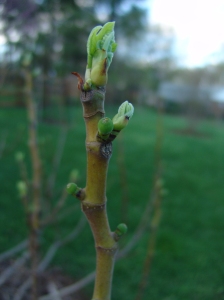I was not optimistic about figs this year, after all we just had snow a week and a half ago. It turns out I was wrong to doubt.
Not only did everyone of the figs I rooted last April from USDA/UCDAVIS cuttings survive with every branch and every bud alive, many are already sprouting peduncles (early stage of fig fruit). If you check out my list of figs at the end of the post, you’ll see why I worried about loosing a few. Many are California fig industry varieties, and I live in the colder half of zone 7.
LSU Purple was the first to show signs of leaf growth a week ago, and it was the first, by a couple days, to put on breba peduncles. Considering I’ve never had a decent fig off this tree in the 3 years since I planted it, this was a little bit surprising. Last year it set peduncles in March but lost them all in April frosts.
Quickly after LSU Purple, Violette de Bordeaux, the most productive of the figs so far, set its first hints of fruits. VdB is the fig I most recommend based on my gardening experience — the fruits are often large and visually appetizing with a rich purple exterior and strawberry red pulp. But all the other critters like it best too and they don’t like to share. Fig flavor varies somewhat even on the same tree and same crop, but VdB usually has a full figgy flavor with something berry-like mixed in (what the figgy flavor is might be difficult to explain to those who haven’t eaten many figs, and I don’t think I’ll have anymore success at explaining it than I would the flavor of milk to someone unfamiliar with dairy. It tastes like milk…very helpful, eh).
Much to my surprise, the Golden Celeste I rooted from UCDavis cuttings is producing baby figs as well. I’ve had a regular Celeste in the ground for a couple seasons and never had it even attempt fruit production. Since Golden Celeste is bred from the slow to yield Celeste and is reported to be similar in quality, I’m very pleased that it is quick to fruit. So, it just got bumped up to a prime growing location. I think it is nearly safe to say, based on its healthy growth and reviews from Louisiana, that Golden Celeste deserves to be grown widely in Virginia, perhaps as a prefered variety over its parent, Celeste.
I’ve also gotten early fruit production on Stanford capri figs from UCDavis.
Here’s a list of the figs cultivars:
Violette de Bordeaux
LSU Purple
St. Anthony Marseille
Kadota
Celeste
Golden Celeste
White Texas Everbearing
Panachee
Brown Turkey
California Brown Turkey
Hardy Chicago
Adriatic
Dauphine
Stanford
Maslin Edible
Calimyrna
Kalamata
Trojano
Monstrueuse
Pastiliere
Nazarti
Green Ischia/ Verte
White Marseille

